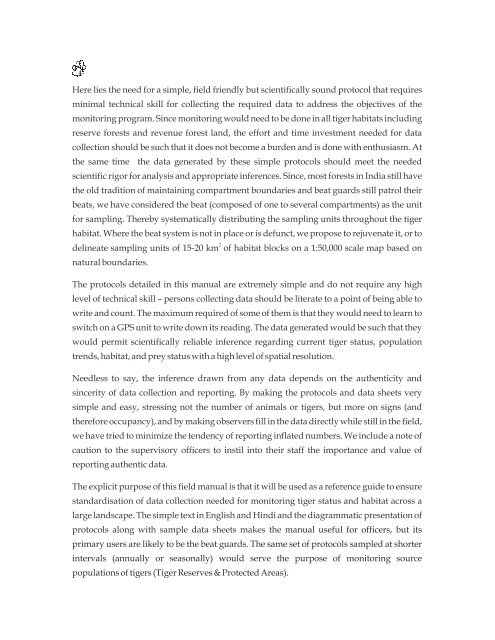FIELD GUIDE Monitoring Tigers, Co-Predators, Prey and their Habitats
FIELD GUIDE Monitoring Tigers, Co-Predators, Prey and their Habitats
FIELD GUIDE Monitoring Tigers, Co-Predators, Prey and their Habitats
You also want an ePaper? Increase the reach of your titles
YUMPU automatically turns print PDFs into web optimized ePapers that Google loves.
4<br />
Here lies the need for a simple, field friendly but scientifically sound protocol that requires<br />
minimal technical skill for collecting the required data to address the objectives of the<br />
monitoring program. Since monitoring would need to be done in all tiger habitats including<br />
reserve forests <strong>and</strong> revenue forest l<strong>and</strong>, the effort <strong>and</strong> time investment needed for data<br />
collection should be such that it does not become a burden <strong>and</strong> is done with enthusiasm. At<br />
the same time the data generated by these simple protocols should meet the needed<br />
scientific rigor for analysis <strong>and</strong> appropriate inferences. Since, most forests in India still have<br />
the old tradition of maintaining compartment boundaries <strong>and</strong> beat guards still patrol <strong>their</strong><br />
beats, we have considered the beat (composed of one to several compartments) as the unit<br />
for sampling. Thereby systematically distributing the sampling units throughout the tiger<br />
habitat. Where the beat system is not in place or is defunct, we propose to rejuvenate it, or to<br />
2<br />
delineate sampling units of 15-20 km of habitat blocks on a 1:50,000 scale map based on<br />
natural boundaries.<br />
The protocols detailed in this manual are extremely simple <strong>and</strong> do not require any high<br />
level of technical skill – persons collecting data should be literate to a point of being able to<br />
write <strong>and</strong> count. The maximum required of some of them is that they would need to learn to<br />
switch on a GPS unit to write down its reading. The data generated would be such that they<br />
would permit scientifically reliable inference regarding current tiger status, population<br />
trends, habitat, <strong>and</strong> prey status with a high level of spatial resolution.<br />
Needless to say, the inference drawn from any data depends on the authenticity <strong>and</strong><br />
sincerity of data collection <strong>and</strong> reporting. By making the protocols <strong>and</strong> data sheets very<br />
simple <strong>and</strong> easy, stressing not the number of animals or tigers, but more on signs (<strong>and</strong><br />
therefore occupancy), <strong>and</strong> by making observers fill in the data directly while still in the field,<br />
we have tried to minimize the tendency of reporting inflated numbers. We include a note of<br />
caution to the supervisory officers to instil into <strong>their</strong> staff the importance <strong>and</strong> value of<br />
reporting authentic data.<br />
The explicit purpose of this field manual is that it will be used as a reference guide to ensure<br />
st<strong>and</strong>ardisation of data collection needed for monitoring tiger status <strong>and</strong> habitat across a<br />
large l<strong>and</strong>scape. The simple text in English <strong>and</strong> Hindi <strong>and</strong> the diagrammatic presentation of<br />
protocols along with sample data sheets makes the manual useful for officers, but its<br />
primary users are likely to be the beat guards. The same set of protocols sampled at shorter<br />
intervals (annually or seasonally) would serve the purpose of monitoring source<br />
populations of tigers (Tiger Reserves & Protected Areas).

















